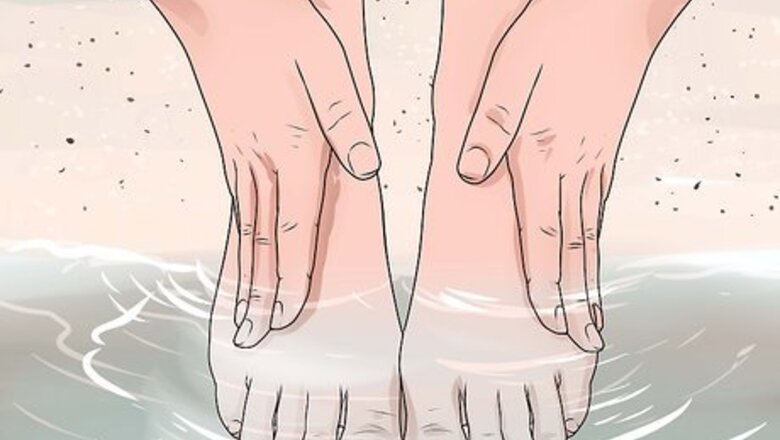
views
- Immediately rinse the wound with salt water (sea water is perfectly fine) to remove debris and bacteria.
- Put on rubber gloves and remove the stinger with tweezers.
- Soak the wound in hot water for 30-90 minutes to neutralize venom.
- Take an over-the-counter anti-inflammatory (like ibuprofen), then go to the ER right away so a medical professional can assess the wound.
Dealing with a Stingray's Sting
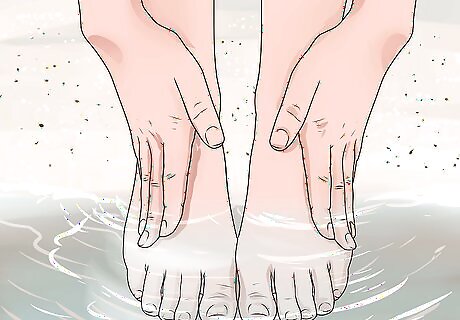
Wash the area with salt water. Stingray stings are one of the most common significant injuries on tropical and warm water beaches and reefs. If you are stung, you'll very likely be in salt water, so it'll be easy to rinse the injury out before attempting anything else. The salt water will wash away any debris and help sanitize/clean your wound from any bacteria that may have been introduced into it or around it. The pain from a stingray sting is sharp and excruciating, so it may be difficult to keep calm and think clearly. So before running out of the water, take a few seconds to clean around the puncture wound. The most common areas to be stung by stingrays are the foot and lower leg. Your upper body and arms are the second-most common areas.
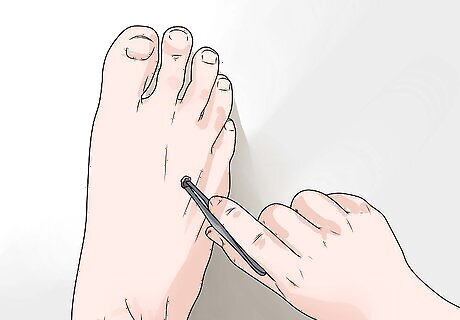
Remove the stinger with tweezers. Usually the stinger stays attached to the tail of a stingray when it attacks, but sometimes it will stay stuck in the wound. The size of stingers depends on the size of the stingray, but most are a little smaller and shorter than knitting needles — which is still a significant size to be punctured with. As long as the stinger isn't very large and stuck through an internal organ or major artery, it's best to quickly remove it with tweezers or by a steady hand while wearing thick rubber gloves. Most stingers produce poisonous venom, so be careful handling them. Removing a stinger can be more painful in the short-term because of its serrated edges tearing tissue as you pull it out. However, removing it quickly may prevent more venom from getting into your wound, which is beneficial in the longer term. Pulling out a stinger will also cause more blood to seep out of the wound for a few minutes, but it can help flush out any debris and bacteria. Be sure to rinse it in more sea water to help clean it. Pulling out a stinger from an organ or major artery may trigger massive and fatal bleeding, so in these circumstances leave it in and seek medical attention as quick as you can.
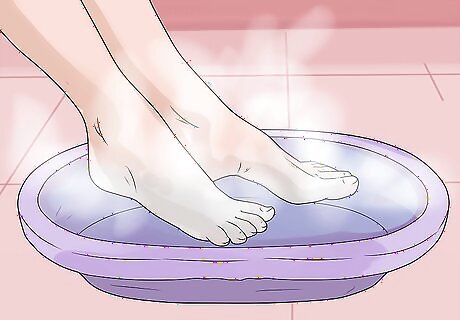
Soak the wound in hot water. The most helpful thing you can do to combat the painful effects of the venom is to submerge your injury (preferably with the stinger removed) in hot water. The ideal temperature for the water is about 110 F or so, but soak the wound in water as hot as you can tolerate it without burning your skin. The hot water denatures (destroys) the protein in the venom, which renders it harmless, and the heat also helps to sanitize the wound. Soak your wound for between 30-90 minutes while maintaining the temperature of the water. Additional symptoms caused by the venom include: swollen lymph nodes near the wound, difficulty breathing, elevated heart rate, reduced blood pressure, nausea, vomiting, fever, chills, muscle cramps, headache, fainting, and/or seizures. Be sure to test hot water for young children first before you soak their wounds in hot water. The area around the puncture wound will swell and turn dark red, sometimes with a bluish tint. Although the pain from the sting is most immediate and typically peaks in 1-2 hours, the symptoms from the venom can escalate over 2 days. You may notice swelling or discoloration around the sting, but more severe symptoms could include nausea, vomiting, abdominal pain, shortness of breath, headache, seizures, or necrosis.

Take over-the-counter (OTC) anti-inflammatories. Some of the pain related to a stingray's sting is due to swelling of the puncture wound. Therefore, taking an OTC non-steroidal anti-inflammatory (NSAID), such as ibuprofen (Motrin, Advil) or naproxen (Aleve), can be very helpful to reduce some discomfort in the short term. Painkillers such as acetaminophen (Tylenol, Paracetamol) can be used for the pain of stings too, but they don't impact the swelling. Anti-inflammatories and analgesics (painkillers) should be considered short-term strategies for pain control while you get to the nearest hospital or walk-in clinic and receive medical attention. If you are bleeding profusely from the stingray's puncture wound, then take acetaminophen for some pain relief instead of NSAIDs because they tend to "thin" the blood and reduce your body's clotting ability.
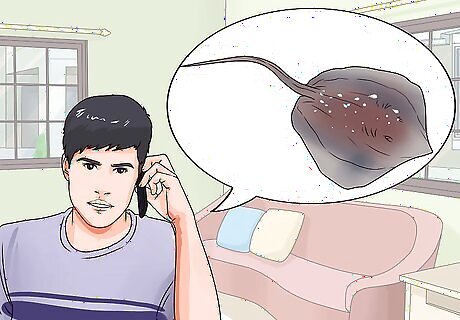
Get medical attention. Although basic first aid, hot water, and anti-inflammatories are certainly helpful, a wound from a stingray almost always needs medical attention. Before calling 9-1-1 or going to the emergency department, it's best to determine the person's age, weight, and condition, as well as the time of the sting, so the doctors can assess the potential seriousness of the situation. A smaller person (child) has a much greater risk of serious complications from the venom than a larger person. For immediate pain control, the doctor will likely inject a local anesthetic into and around the wound. Nerve blocks can also be used. Oral antibiotics may be given to prevent infection if the wound is deep or there is a significant delay in seeking treatment. Your doctor may also give opioids for severe pain. The wound will be thoroughly cleaned, although stitches may not be applied until the doctor is confident that there's a great risk of infection. You also might get a tetanus shot. If the stinger is venomous (not all are) antiserum medication will be given to reverse the side effects of the venom. Your doctor also might want to do x-rays or another form of imaging to make sure that there are no barbs that are still stuck in your skin and to assess any internal damage that could have been done by penetrating barbs. If someone was stung in the chest or abdomen, consider getting an EKG and lab work so your doctor can monitor your cardiac activity. If they’re concerned about more severe side effects, like shock, they’ll transfer you somewhere with an ICU.
Avoiding the Risk of Stings
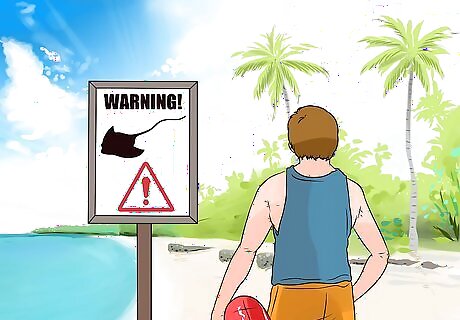
Don't swim with stingrays. Although stingrays tend to be non-aggressive creatures who try to avoid or escape from people, some larger species may confuse people as prey or as hostile threats. "Crocodile Hunter" Steve Irwin died as a result of a stingray attack back in 2006, even though he thought he was safe. He was punctured multiple times through the lungs and heart and died shortly thereafter from the wounds. Thus, the best prevention for avoiding stings is to never knowingly swim with them and avoid areas/beaches that are considered their habitat. Talk to local fishermen or surfers who are familiar with the coastlines and beaches about what areas to avoid. Don't touch dead stingrays. The stingers obviously remain sharp after death, but venom can still be secreted from them also, so don't pick one up. If you’re fishing and catch a stingray, cut it from the line rather than trying to untangle it. Avoid swimming too close to the seafloor since a stingray could easily reach you.
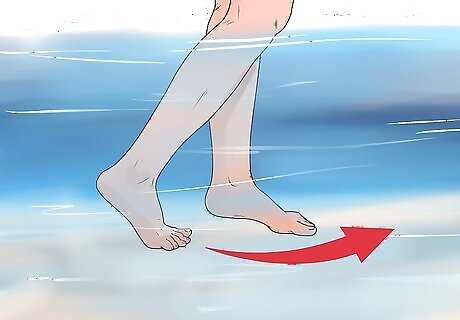
Shuffle your feet while you walk. If you have no intention of avoiding tropical and temperate beaches, then you should learn how to minimize the risk of stepping on a stingray. The best technique seems to be to slide or shuffle your feet through the sand instead of lifting your feet and taking steps. The stingrays detect this from a distance and swim away before you have a chance to accidentally step on them. Stamping on the bottom as you slowly tread through murky water can also scare stingrays off from a distance. You can also use a pole to poke the sand ahead of you before taking a step forward. Wearing footwear while in the water doesn't really make a difference in preventing a stingray injury. The stingers can easily penetrate rubber and nylon material.
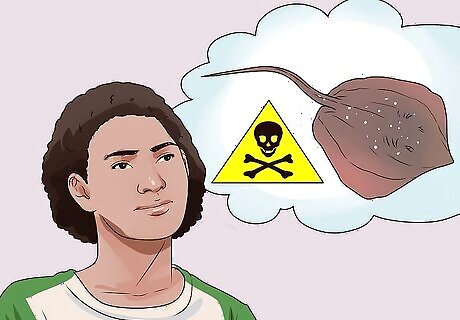
Identify poisonous species. If you're scuba diving or snorkeling, learn to identify poisonous and/or aggressive species of stingrays (and other sea creatures) beforehand. The internet is full of information and colorful pictures to help you identify the different species of rays. Some, such as the manta ray, have no stinger and are harmless to people. Before going on a tropical beach holiday, prepare yourself and your family with this helpful info. Learning the general habits of the local species while on vacation can keep you from getting into risky situations. Stingray injuries often occur in late summer and early fall, when they burrow in the sand in shallow surf. While most stingrays live in salt water, there are a few freshwater species that have venom that’s more toxic. Avoid going to remote areas that are isolated from medical help. The profuse bleeding and venom can be life-threatening if medical help is delayed by more than a few hours.




















Comments
0 comment